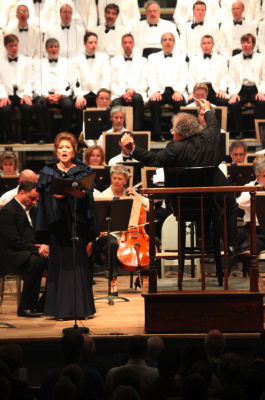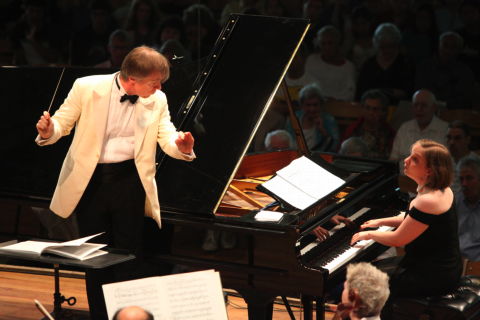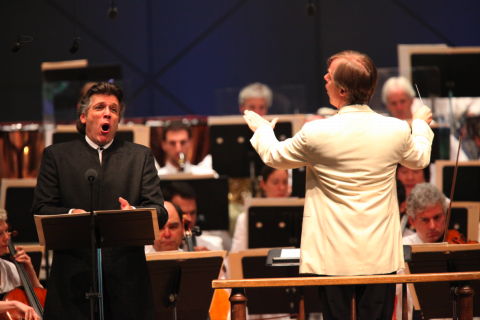|

Tonal Luxuriance
LAWRENCE BUDMEN reports
from Tanglewood 2009
Johannes Brahms' Ein deutsches Requiem ('A German Requiem'), Opus 45 is one of the monuments of the choral-orchestral literature. Instead of setting the traditional mass for the dead, Brahms based his deeply personal work on texts from biblical scriptures. The composer created some of his most spiritually contemplative music for this score; yet, while properly reverent, this masterpiece is uplifting, soaring to exalted heights. This pillar of nineteenth century liturgical concert tradition formed the centerpiece of James Levine's final weekend at Tanglewood, the Boston Symphony Orchestra's annual summer festival in Lenox, Massachusetts, USA on 25 July 2009.
After five seasons as music director of the Boston ensemble, Levine has made this orchestra very much his own. Drawing a dark well of tonal richness from his musicians, Levine proved a Brahmsian of uncommon majesty. Emotionally riveting from the serene opening bars to the final meditative section, Levine's sweeping eloquence and ruminative strophes of lyrical contemplation propelled an authentically great performance, enhanced in no small way by the spacious acoustics of the Koussevitzky Music Shed -- the perfect space for large scale choral performances.

Hei-Kyung Hong, James Levine and members of the Boston Symphony Orchestra and Tanglewood Festival Chorus performing Brahms' German Requiem. Photo © 2009 Hilary Scott
|
The remarkable Tanglewood Festival Chorus under the superb direction of John Oliver, singing without scores, was resplendent, always producing a firmly focused core of tonal luxuriance. In the soprano solo Ihr habt nun Traurigkeit ('Ye now have sorrow'), the radiant purity of Hei-Kyung Hong's voice took magical flight. Rich, dark, manly and assertive, Matthias Gorne's baritone solos recalled the finely chiseled artistry of Dietrich Fischer-Dieskau. The final eternal peace of Selig sind die Toten ('Blessed are the dead') was poignantly evoked by Levine, concluding a performance that would be difficult to surpass.
The previous evening (24 July) Levine and the BSO battled the heavens as a tumultuous thunderstorm enveloped the Berkshires during a Berlioz-Mussorgsky program. The conductor captured the mercurial shifts of mood and tone in Harold in Italy, uncovering elegance beneath the barn-burning orchestral pyrotechnics. Principal violist Steven Ansell displayed prized musicianship in the instrument's narrative role although his tonal compass was not large. Levine's approach to Pictures at an Exhibition (in the familiar Ravel orchestration) was intelligently conceived and cogently stated, unfurling scintillating orchestral playing. Broadly paced, the Great Gate at Kiev had power to spare.
The scope of Levine's artistry was brought into focus by the one program of the weekend that he did not conduct -- a Sunday matinee (26 July) featuring American music of the 1940s and early 50s under the direction of David Robertson. Robertson, music director of the St Louis Symphony and principal guest conductor of the BBC Symphony Orchestra, was a technically adept podium artist but needed greater artistic insight and a modicum of inspiration for his survey of mid 20th century Americana.
Two Koussevitzky-Boston Symphony commissions bookended the program. The Third Symphony of Roy Harris (1898-1979) is an American classic, combining indigenous folk based elements with an aura of deep, elemental sadness. Robertson's flashy, superficial conducting totally missed the score's tragic grandeur. The Boston Symphony players excelled in Harris' massive contrapuntal writing, delivering a crisp, brilliantly executed performance.

Orli Shaham and David Robertson performing Bernstein's 'The Age of Anxiety'. Photo © 2009 Hilary Scott
|
Leonard Bernstein's Symphony No 2 -- The Age of Anxiety (1949) is a highly uneven work -- a cavalcade of Bernstein's divergent compositional strains. Noble lyricism shares space uncomfortably with jazzy pianistic riffs and acerbic dissonance. Robertson's often sluggish conducting lacked the rhythmic bite and vitality that Bernstein and, more recently, Marin Alsop have brought to this problematical score. In this traversal, the music was reduced to Hollywood soundtrack status. Paradoxically, Orli Shaham (Robertson's wife) was an emphatic piano soloist, dazzling in Bernstein's bravura keyboard writing; instilling some of the fizzy panache that was lacking from the podium.
The refined artistry of baritone Thomas Hampson took center stage in Virgil Thomson's rarely heard Five Songs from William Blake (1952) and three of Samuel Barber's songs that are more familiar in versions with piano, rather than orchestral, accompaniment. Thomson's typical fusion of American and European stylistic ethos permeate his Blake song cycle. Homespun simplicity meets Gallic sophistication. Hampson's lustrous, subtly conveyed vocalism made a strong case for Thomson's sensitive settings. Barber's 1952 orchestrations enhanced the signature lyricism of Sure on this shining night and Nocturne and added surprising astringency to I hear an army (after James Joyce's text). Hampson's Technicolor performances were capably supported by Robertson and reduced instrumental forces.

Thomas Hampson with David Robertson and members of the Boston Symphony Orchestra. Photo © 2009 Hilary Scott
|
On 22 July Hampson offered A Program of American Song, a panorama of American history encompassed in wide ranging art song literature. The wood paneled interior of Seiji Ozawa Hall provided a welcome frame for Hampson and his stellar piano accompanist Craig Rutenberg, the epitome of artistic partnership. Varied offerings encompassed both the colonial parlor song My Days Have Been So Wondrous Free by Francis Hopkinson (a signer of the Declaration of Independence) and an entire second half devoted to the iconic Charles Ives.
Among the highlights of this unique concert were the moving, rhetorical Ethiopia Saluting the Colors (after Walt Whitman's poem) by the African American Henry T Burleigh (a pupil of Dvorák); the remarkably unmoored harmonies of the Omaha Indian based Song of the Deathless Voice by Arthur Farwell (who counted MacDowell, Chadwick, Humperdinck and Pfitzner among his teachers); Amy Beach's rhapsodic Twilight; an eloquent Letter to Mrs Bixby from the 2009 song cycle Letters from Lincoln by the iconoclastic Michael Daugherty and Leonard Bernstein's inspired outburst of melody in To What You Said, based on Walt Whitman's unpublished poem about his secretive homosexuality. Fractured meters, eerily strange harmonic progressions, exhilarating wit and irony and wild pianistic tone clusters mark Charles Ives as a master of originality. In a more traditional vein, his ruminative The Housatonic at Stockbridge conveys the rhapsodic flow of the river.
For encores Hampson brought full voiced nobility to the traditional Shenandoah, redefining this familiar ballad as a true American art song, and rollicking vocal splendor to Aaron Copland's Boatman's Song. Hampson's recital tour of American song is indeed a national treasure.
At a 25 July matinee in Ozawa Hall, Italian born Federico Cortese conducted the Boston University Tanglewood Institute Young Artists Orchestra. This high school level orchestra, a collaborative effort of the Boston University College of Fine Arts and the Tanglewood Music Center, played with brilliance and full toned vibrancy that would surpass many a respected second tier ensemble. Cortese, a former assistant to Seiji Ozawa, Robert Spano and Daniele Gatti, proved a first rate orchestral technician who achieved miraculous performances from his eager young players.
Opening with a bright, bouncy version of Gershwin's Cuban Overture that spotlighted languid, sensuous strings and strong brass, Cortese achieved a remarkably precise and crisp rendition of Beethoven's Egmont Overture. The concert's tour de force was an intense performance of Bartók's Concerto for Orchestra, played with sizzling brilliance. Cortese captured the score's feverish aura as well as its eloquence and pathos, qualities that elude many conductors. The Boston based Cortese is a major podium talent!
Copyright © 5 September 2009
Lawrence Budmen,
Miami Beach, USA

The summer season at Tanglewood in Lenox, Massachusetts, USA concludes with the Tanglewood Jazz Festival. The event opened on Friday 4 September 2009 with An Evening with Paquito d'Rivera. Saturday 5 September brings John Pizzarelli and Jessica Molskey with Bucky Pizzarelli, Aaron Weinstein and Harry Allen (matinee). An evening double bill features the Regina Carter Quartet and Dreaming the Duke (Ellington) with soprano Harolyn Blackwell, Ninenna Freelon and Mike Garson. A matinee performance on Sunday 6 September offers A Piano Duet with Kenny Barron and Mulgrew Miller. The festival concludes with A Triumph of Trumpets with the Jon Faddis Quartet and the David Holland Octet. All concerts take place at Seiji Ozawa Hall. See www.tanglewood.org for more information. |
|

